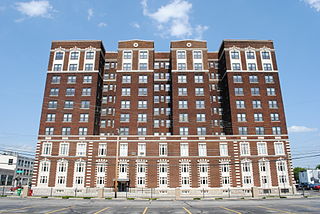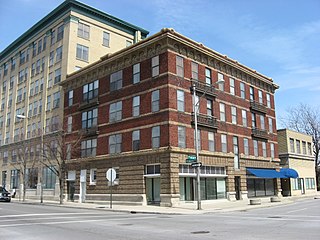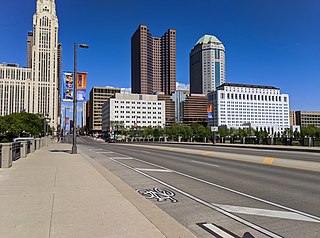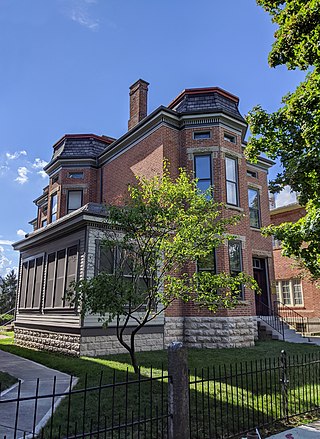
The LeVeque Tower is a 47-story skyscraper in Downtown Columbus, Ohio. At 555 feet 5 inches (169.29 m) it was the tallest building in the city from its completion in 1927 to 1974, and remains the second-tallest today.

The Seneca, formerly known as the Seneca Hotel, is a 10-story apartment complex and former hotel in the Discovery District of downtown Columbus, Ohio. The brick building was designed by architects Frank Packard and David Riebel & Sons and built in 1917, in a prominent location near Franklin County Memorial Hall, where conventions were held. A four-story wing was built on the hotel's east side in 1924. The hotel closed in the mid-20th century, and it held the Nationwide Beauty Academy from 1960 to 1974. Dormitories held female students for Nationwide and about six other public and private schools downtown. The Seneca became home to the Ohio Environmental Protection Agency from 1976 to 1987. The building was added to the National Register of Historic Places in 1983 and the Columbus Register of Historic Properties in 1991. In 1988, the building became vacant, and remained that way until 2005.

The Wilson is a historic Renaissance Revival apartment building located at 643 Fort Wayne Avenue in Indianapolis, Indiana, United States. It was built in 1905 amid an apartment-building boom; more than fifty such apartment buildings were completed in what is now central Indianapolis in 1905 alone.

The Barr Hotel is a historic hotel on the eastern side of downtown Lima, Ohio, United States. Built in 1914, the Neoclassical hotel occupies the northeastern corner of the intersection of High and Union Streets.

The Ford Motor Company - Columbus Assembly Plant is a historic building in Downtown Columbus, Ohio. The Ford plant was constructed in 1914, to designs by John Graham. The plant operated until 1939. In later years, it became the Kroger Co. Columbus Bakery, operating until 2019. The building was sold in 2020, and is planned to be redeveloped into a large residential complex, announced in 2021. The building was added to the National Register of Historic Places and Columbus Register of Historic Properties in 2021.

The Atlas Building, originally the Columbus Savings & Trust Building, is a high-rise building in Downtown Columbus, Ohio, built in 1905 and designed by Frank Packard. It was added to the National Register of Historic Places in 1977. The building has seen two major renovations, in 1982 and 2014.

The Priester Building is a historic building located just north of Downtown Davenport, Iowa, United States. The low-rise office building was built for the headquarters of Priester Construction Company, and its real estate division, in 1958. The well-preserved structure is significant as an excellent example of the late International Style. It was designed by San Francisco architect John ("Jack") W. Kruse, formerly of Davenport, and the local architectural firm of Parish and Richardson. That firm has its roots in the architectural practice of prominent Davenport architect Frederick G. Clausen. It is believed that this was the first modernistic commercial design in Davenport, and it brought West Coast cutting-edge architecture to the Midwest. It is also noteworthy for its location in the side of a hill and the difficulties that presented for construction, and the first-ever use of a plastic shell for winter-time construction in the city. The T-shaped building rises three-stories to the height of 39.29 feet (11.98 m). It features perimeter landscaping, a curved mosaic wall on the west elevation to deflect traffic noise from Brady Street, views to the south and west that reflected weather and sun conditions on design and operating conditions, and it is fully air conditioned.

The Columbus Dispatch Building is a historic building on Capitol Square in Downtown Columbus, Ohio. The building was home to the Columbus Dispatch newspaper offices until January 2016, when it moved to 62 E. Broad St. on Capitol Square. A renovation restored the building closer to its original exterior appearance, while adding modern features. The building is now headquarters to the Ohio Chamber of Commerce. The building is owned by Capitol Square Ltd., a real estate and development branch of the Wolfe family’s Dispatch Printing Co., the former owners of the Dispatch. The site formerly housed the city's downtown YMCA, a Yost & Packard building; the Y moved to the Downtown YMCA building in 1923.

The Downtown YMCA is a historic former YMCA building in Downtown Columbus, Ohio. It was the largest YMCA resident facility in the United States. It was listed on the National Register of Historic Places in 1993. The seven-story building was designed in the Jacobethan Revival and Late Gothic Revival styles by Chicago architecture firm Shattuck & Layer.

The Citizens Building is a historic building in Downtown Columbus, Ohio. It was listed on the Columbus Register of Historic Properties in 2013, and was listed as part of the High and Gay Streets Historic District, on the National Register of Historic Places, in 2014.

The Empire Building, also known as the Yuster Building, is a historic building in Downtown Columbus, Ohio. It was listed on the National Register of Historic Places in 2017. The eight-story Empire Building has Gothic-inspired commercial architecture. Its main tenant is also the building owner, Continental Real Estate. The Credit Union of Ohio operates on its ground floor.

Broad Street is a major thoroughfare in Central Ohio, predominantly in Franklin County and Columbus. It stretches east from West Jefferson at Little Darby Creek to Pataskala. The street is considered one of Columbus's two main roads, along with High Street.

The Greater Columbus Arts Council (GCAC) is an arts organization in Columbus, Ohio. The council funds artists and organizations in Central Ohio, and hosts the annual Columbus Arts Festival.

The Columbus Landmarks Foundation, known as Columbus Landmarks, is a nonprofit historic preservation organization in Columbus, Ohio. The foundation is best-known for its list of endangered sites in the city and its annual design award, given to buildings, landscapes, and other sites created or renovated in Columbus. It was established in 1977 as a project of the Junior League of Columbus, Ohio, following the demolition of the city's historic Union Station. It is headquartered at 57 Jefferson Avenue, a contributing structure in the Jefferson Avenue Historic District in Downtown Columbus.

The Jaeger Machine Company Office Building is a historic building in the Arena District neighborhood of Columbus, Ohio. It was listed on the National Register of Historic Places in 1983.

Gaetz Music House is a historic building in Downtown Columbus, Ohio. It was listed on the National Register of Historic Places in 2014.

The Ohio Finance Building is a historic building in Downtown Columbus, Ohio. It was listed on the National Register of Historic Places in 2014.

The Stoddart Block is a historic building in Downtown Columbus, Ohio. It was listed on the National Register of Historic Places in 1994. The building was constructed in 1911 and designed by the local firm David Riebel & Sons. It was designed for a large furniture store, the Frohock Furniture Company, which operated there until 1938. A second furniture company, Hadley's Furniture Company, occupied the building until 1962. It then operated as the Children's Hospital's thrift shop, from 1962 to 1990. By 2014, the building held 52 low-income apartments. It was renovated into affordable micro-apartments at this time.

The Avery Pontiac Building is a historic building in Columbus, Ohio. It is located in Columbus's Near East Side, roughly between the Franklin Park and Olde Towne East neighborhoods. The building was added to the Columbus Near East Side District in 1978. It was individually listed on the Columbus Register of Historic Properties in 1984.

The Trolley District is a mixed-use complex in Columbus, Ohio. The three-acre (1.2 ha) site houses the East Market, a public market and food hall, as well as two bars, and will also include restaurants, a brewery, and event space, with neighboring apartments. The property is located in the city's Franklin Park neighborhood and is a contributing part of the Columbus Near East Side District, listed on the National Register of Historic Places.





















